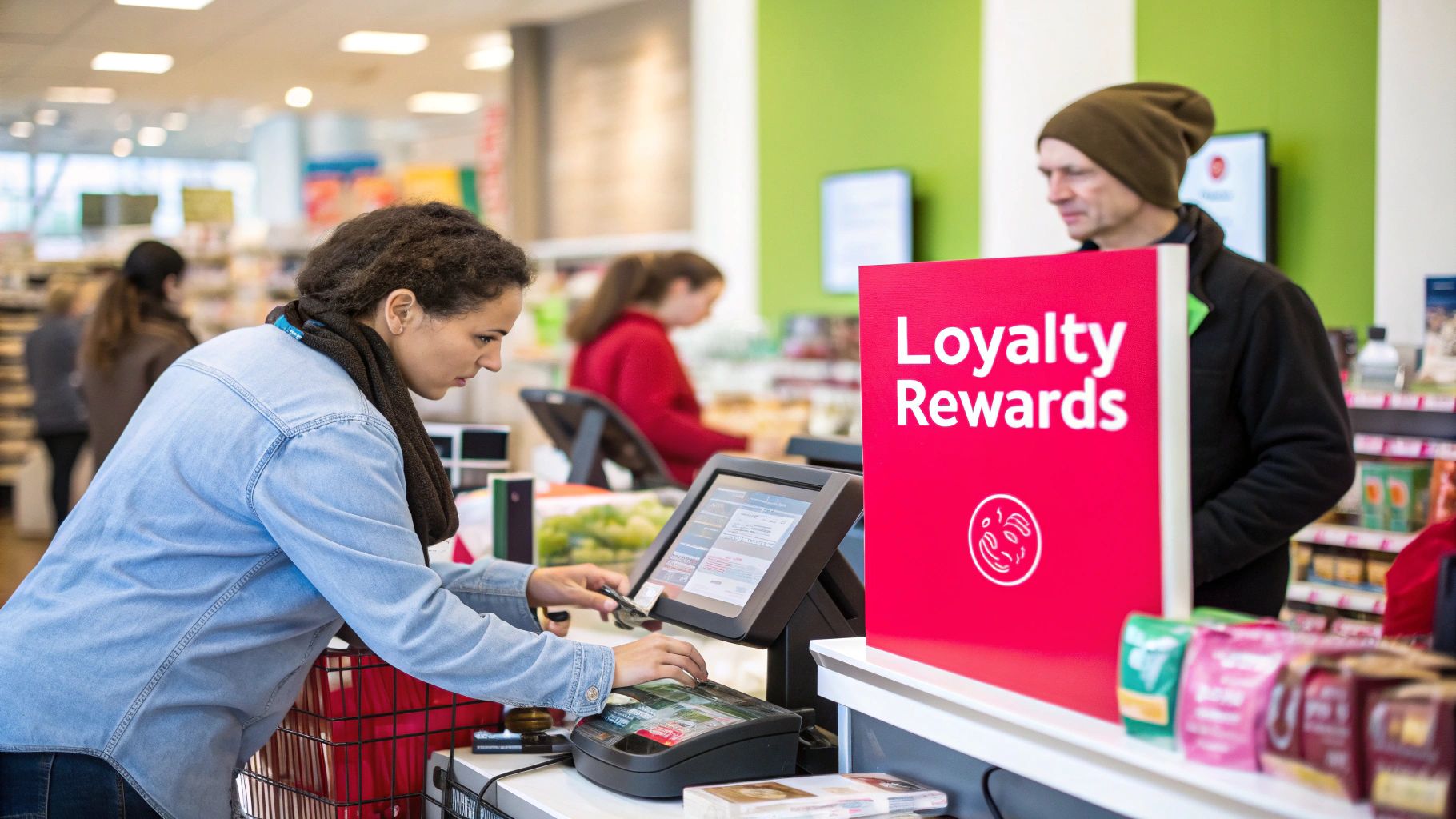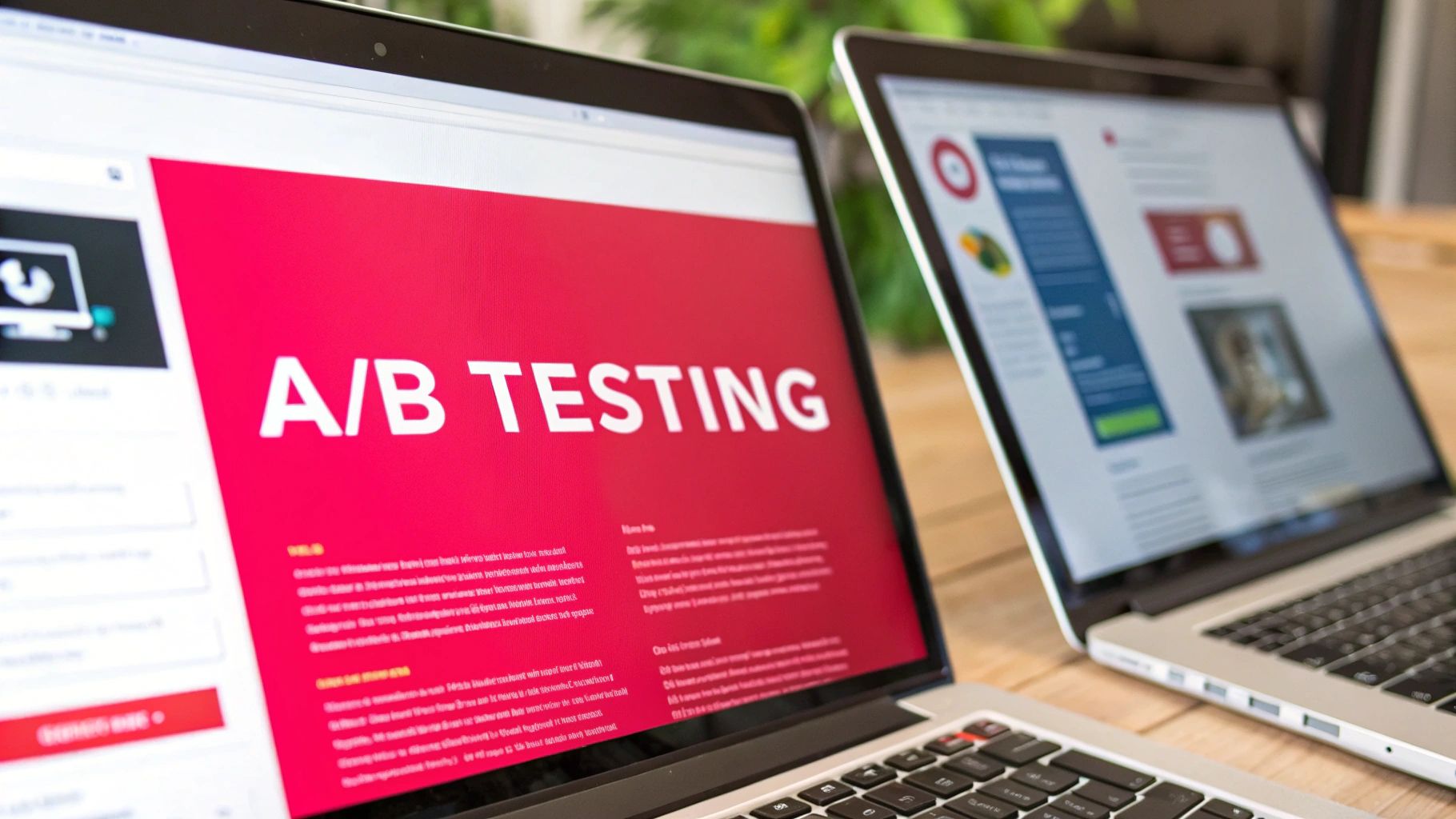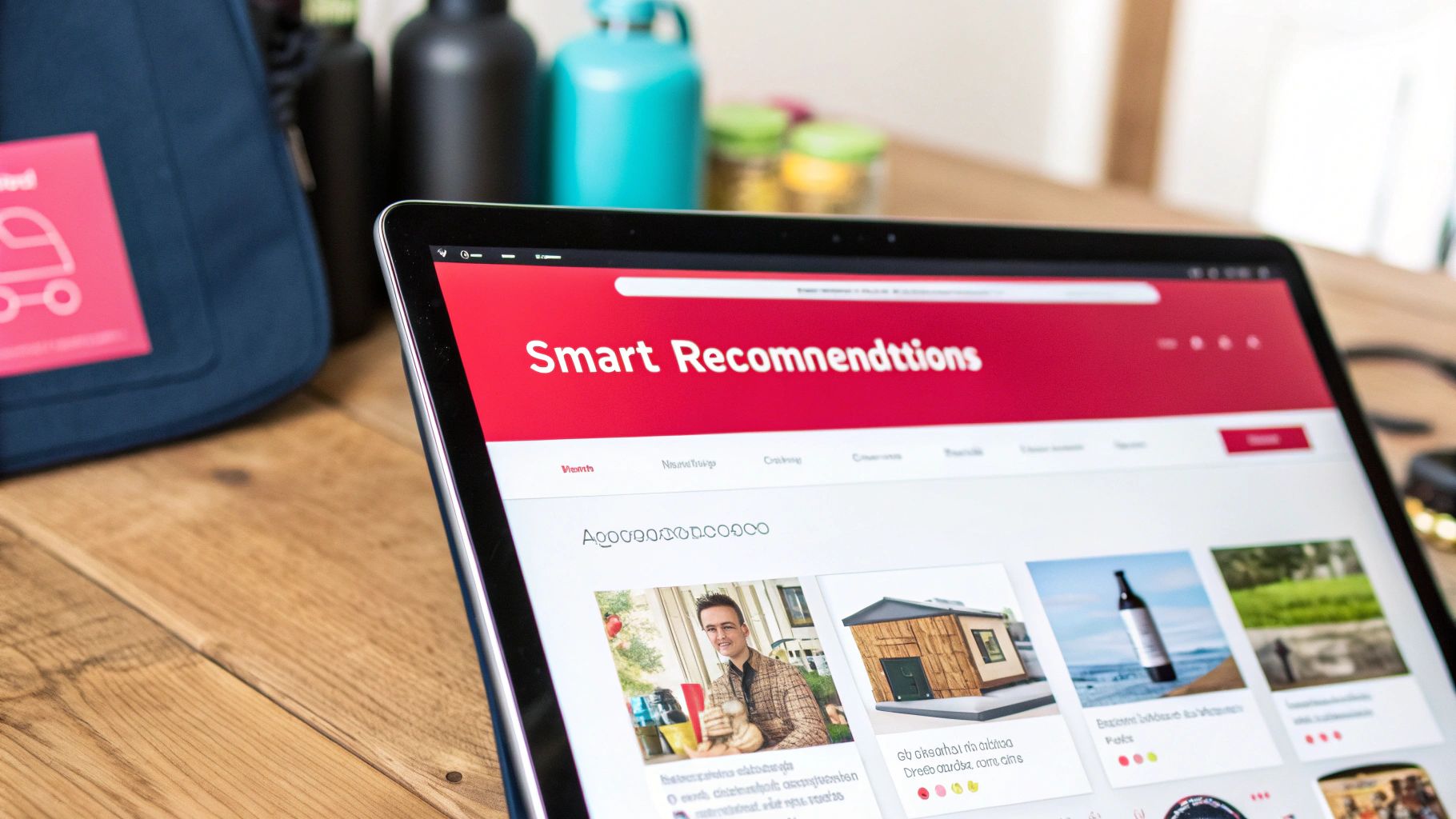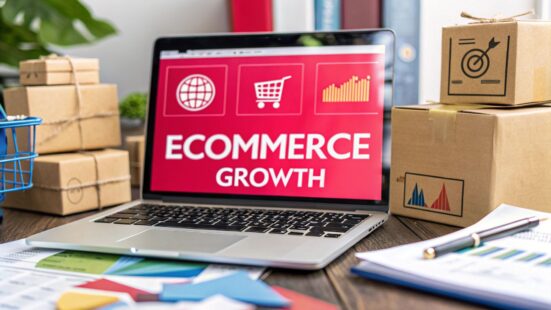 Your Guide to Understanding TikTok GMV
Your Guide to Understanding TikTok GMV
The ecommerce landscape is evolving faster than ever. What worked last year might not cut it today. To not just survive but thrive, you need a dynamic, multi-faceted approach. This guide cuts through the noise, offering 10 proven ecommerce growth strategies that address every stage of the customer journey, from acquisition and conversion to retention and advocacy. We'll move beyond generic advice and provide actionable blueprints, real-world examples, and fresh perspectives on what it takes to scale your online store.
This is not just another list of vague tips. Instead, you will find specific, practical implementation details for each strategy, covering everything from mobile-first optimization and social commerce to subscription models and AI-driven personalization. We will explore how to:
- Boost retention with loyalty programs that create true brand advocates.
- Optimize conversions by fine-tuning every touchpoint of your site.
- Implement automation to nurture leads and drive repeat purchases.
- Integrate channels for a seamless omnichannel customer experience.
Whether you're a burgeoning DTC brand or an established retailer, these strategies are your roadmap to unlocking sustainable growth and building a resilient business in a competitive digital marketplace. Let's dive in and transform your growth trajectory.
Table of Contents
1. Master Customer Retention with Next-Generation Loyalty Programs
While many ecommerce growth strategies focus on acquiring new customers, a truly sustainable model prioritizes keeping the ones you already have. Modern loyalty programs move beyond simple point systems to create a sense of community and exclusivity. This approach is founded on the principle that it's significantly more cost-effective to retain an existing customer than to acquire a new one. By rewarding repeat business, you build a loyal base that not only buys more but also acts as a powerful brand advocate.

Successful programs like Sephora's Beauty Insider and Nike Membership demonstrate the power of tiered rewards, exclusive product access, and community-driven events. These programs make customers feel like insiders, fostering an emotional connection that transcends transactional relationships. The key is to provide genuine, tangible value that aligns with your brand's core identity.
How to Implement This Strategy
- Start with a Tiered Structure: Begin with a simple point-based system (e.g., 1 point per dollar spent) but create tiers. As customers spend more, they unlock higher tiers with enhanced benefits like free shipping, early access to sales, or exclusive products. This gamifies the experience and encourages higher lifetime value.
- Integrate Experiential Rewards: Don't just offer discounts. Consider rewards like invitations to digital events, personalized styling consultations, or access to a members-only forum. These experiences build a stronger community around your brand.
- Leverage Customer Data for Personalization: Use purchase history and browsing behavior to offer personalized rewards. If a customer frequently buys a specific product category, offer them double points or an exclusive discount on a related item.
- Promote Your Program Everywhere: Ensure your loyalty program is visible on your homepage, product pages, checkout process, and in all email marketing communications. Clearly articulate the value proposition to drive sign-ups.
2. Implement a Rigorous Conversion Rate Optimization (CRO) Program
Driving traffic to your store is only half the battle; the real growth happens when you convert those visitors into customers. Conversion Rate Optimization (CRO) is a systematic process for increasing the percentage of visitors who take a desired action. This data-driven ecommerce growth strategy involves analyzing user behavior, gathering feedback, and running controlled A/B tests to refine the user experience and eliminate friction in the buying journey. By continuously improving key pages, you can generate more revenue from your existing traffic.

Industry leaders like Amazon pioneered CRO with innovations like one-click checkout, drastically reducing purchase friction. Similarly, Booking.com runs thousands of simultaneous A/B tests to optimize every element, from button colors to social proof messaging. The core principle is that small, incremental improvements accumulate over time, leading to significant gains in revenue and customer satisfaction without increasing marketing spend.
How to Implement This Strategy
- Focus on High-Impact Pages First: Begin your CRO efforts where they will matter most: your product pages and the checkout process. Analyze user recordings and heatmaps to identify drop-off points, then hypothesize changes to test.
- Test One Element at a Time: To get clear, unambiguous insights, isolate your variables. Test a single change, such as the headline, call-to-action button text, or product image, to understand its specific impact on user behavior.
- Prioritize Mobile-First Optimization: With a majority of ecommerce traffic coming from mobile devices, a clunky mobile experience is a major conversion killer. Ensure your site is not just responsive but fully optimized for smaller screens, with large tap targets and a streamlined checkout.
- Document and Learn from Every Test: Maintain a detailed log of every A/B test you run, including your hypothesis, the variant you tested, the results, and the statistical significance. This repository becomes a valuable knowledge base for guiding future optimization efforts.
3. Social Commerce Integration
Social commerce integration is one of the most powerful ecommerce growth strategies, transforming passive scrolling into active purchasing. It bridges the gap between social discovery and online shopping by allowing customers to buy products directly within social media platforms. This removes friction from the buying journey, capitalizing on impulse purchases and leveraging the immense power of social proof, user-generated content, and influencer marketing in a native environment.

Platforms like Instagram and TikTok have evolved from simple marketing channels into robust, shoppable storefronts. Fashion brands like Zara use Instagram's product tags to make entire looks instantly shoppable from a single post, while beauty brands partner with creators on TikTok to drive sales through live shopping events. This strategy meets customers where they are already spending their time, creating a seamless and engaging brand experience.
How to Implement This Strategy
- Set Up Native Shops: Begin by creating storefronts on platforms like Facebook Shops and Instagram Shopping. Sync your product catalog directly from your ecommerce platform (e.g., Shopify, BigCommerce) to ensure inventory and pricing are always up-to-date.
- Invest in High-Quality, Platform-Specific Visuals: Each platform has a unique content style. Create high-resolution images for Instagram, engaging short-form videos for TikTok and Reels, and aesthetically pleasing pins for Pinterest. Your content should feel native to the platform, not like a generic ad.
- Leverage Product Tagging: Consistently tag products in your posts, Stories, and Reels. This simple action adds a direct path to purchase and makes your content instantly shoppable, reducing the number of clicks a customer needs to make.
- Partner with Micro-Influencers: Collaborate with micro-influencers (10k-100k followers) who have a highly engaged and niche audience. Their authentic recommendations can drive significant traffic and sales through tagged products and unique discount codes.
4. Email Marketing Automation
Email marketing automation is a powerful ecommerce growth strategy that moves beyond generic newsletters to deliver personalized, timely messages based on user behavior. By setting up automated workflows, you can nurture leads, recover lost sales, and build lasting customer relationships without manual intervention. This system works by using triggers, such as a customer abandoning their cart or making a purchase, to send a pre-defined sequence of relevant emails. This ensures communication is always contextual and valuable.

Brands like Casper excel at this, using an educational email series to guide new subscribers through the benefits of better sleep, subtly positioning their products as the solution. Similarly, Grammarly's weekly writing insights reports use personalized data to provide value and keep users engaged with the platform. These examples show that automation, when done right, feels less like marketing and more like a personalized service, significantly boosting conversion rates and customer loyalty.
How to Implement This Strategy
- Segment Your Audience: Go beyond basic demographics. Create segments based on purchase history, browsing behavior (e.g., viewed specific product categories), engagement level, and lifecycle stage (e.g., new subscriber, repeat customer, lapsed customer). This allows for hyper-targeted campaigns.
- Develop Key Automation Workflows: Start with the highest-impact automations: a welcome series for new subscribers, an abandoned cart recovery sequence, and a post-purchase follow-up series for feedback or cross-selling. These three workflows can immediately impact revenue.
- Optimize for Mobile and Engagement: A majority of emails are opened on mobile devices. Ensure your templates are responsive and your subject lines are concise and compelling. Use clear calls-to-action (CTAs) that are easy to tap.
- Continuously Monitor and Refine: Track key metrics like open rates, click-through rates, conversion rates, and unsubscribe rates for each automated workflow. A/B test subject lines, content, and send times to consistently improve performance.
5. Build a Cohesive Omnichannel Customer Experience
Today’s customers don’t see channels; they see a brand. An omnichannel customer experience ensures that interaction is seamless and consistent, whether a customer is browsing on a mobile app, visiting a physical store, or contacting support. This strategy unifies sales, marketing, and service touchpoints to create a single, continuous journey, eliminating the friction that arises from siloed operations. By meeting customers wherever they are, you build brand trust and remove barriers to purchase.
Retail giants like Starbucks and Sephora excel at this by integrating their apps, loyalty programs, and in-store experiences. A Starbucks customer can order on their app, pay with their linked card, and pick up in-store without a single hiccup. This cohesion is a powerful driver of both convenience and loyalty, turning isolated interactions into a holistic brand relationship and is one of the most effective ecommerce growth strategies available today.
How to Implement This Strategy
- Map the Entire Customer Journey: Start by visualizing every possible touchpoint a customer has with your brand, from initial discovery to post-purchase support. Identify gaps and inconsistencies where the experience breaks down between channels.
- Invest in Centralized Data Systems: Use a robust CRM or customer data platform (CDP) to create a single view of the customer. This allows your marketing, sales, and service teams to access the same information, ensuring personalized and context-aware interactions.
- Train Staff for Cross-Channel Fluency: Your employees are a critical link. Ensure customer service agents can view online order history and in-store staff can help with app-related queries. This comprehensive training creates a truly unified front.
- Maintain Brand Consistency: Your visual identity, tone of voice, and promotional offers should be consistent across all platforms. A customer should feel they are interacting with the same brand whether on Instagram, your website, or a pop-up shop. Ensuring a smooth and diverse range of payment options is also a critical component, so optimizing payment methods is essential for a truly seamless journey.
6. Personalization and AI-Driven Recommendations
Generic, one-size-fits-all shopping experiences are no longer effective. Modern consumers expect online stores to understand their unique needs and preferences. This is where artificial intelligence (AI) and machine learning become powerful ecommerce growth strategies, enabling you to deliver highly individualized experiences at scale. By analyzing customer behavior, purchase history, and real-time interactions, AI can dynamically tailor product recommendations, content, and even website layouts for each user.
This level of personalization goes far beyond simply using a customer's first name in an email. It’s about creating a smarter, more intuitive shopping journey. Amazon’s legendary "Customers who bought this also bought" feature is a prime example, but modern platforms can now personalize homepages, search results, and promotional offers. This makes customers feel understood and valued, significantly boosting conversion rates and average order value.
How to Implement This Strategy
- Start with Smart Product Recommendations: Implement AI-powered tools on your product and cart pages. Begin with basic algorithms like "Frequently Bought Together" or "Top Sellers in This Category." As you collect more data, you can advance to more sophisticated, individually tailored suggestions.
- Leverage Dynamic Content: Use AI to change homepage banners, featured products, and even marketing copy based on a user's browsing history or location. A visitor who frequently views hiking gear should see different content than one interested in urban fashion.
- Ensure Data Transparency: Be upfront with customers about how you are using their data to improve their experience. A clear privacy policy and easy-to-manage consent options build trust, which is essential for effective personalization.
- A/B Test Your Personalization Efforts: Don't assume your AI's first attempt is the best one. Continuously test different recommendation algorithms, content variations, and placement options to see what drives the highest engagement and revenue.
7. Build a Traffic Moat with Content Marketing and SEO
Content marketing and SEO are foundational ecommerce growth strategies that build long-term, sustainable traffic by earning trust and authority. Instead of constantly paying for clicks, this approach focuses on creating valuable, relevant content that answers your audience's questions and solves their problems. By optimizing this content for search engines, you attract highly qualified organic traffic from potential customers actively looking for information related to your products and niche.
Brands like REI, with its extensive outdoor education guides, and HubSpot, with its comprehensive marketing blog, exemplify this strategy. They don't just sell products; they become the go-to resource in their field. This establishes them as thought leaders, building a loyal following that trusts their recommendations and, ultimately, buys their products. To truly build a traffic moat and ensure your ecommerce business stands out, implement these proven strategies to improve website visibility in 2025.
How to Implement This Strategy
- Focus on Search Intent: Move beyond simple keyword stuffing. Understand the "why" behind a search query. Is the user looking to learn, compare, or buy? Create content that directly addresses that intent, whether it's a "how-to" guide, a product comparison, or a detailed case study.
- Create Topic Clusters: Organize your content around core "pillar" pages that cover a broad topic, then link out to more specific "cluster" blog posts. This internal linking structure signals your expertise on a subject to search engines like Google, boosting your authority and rankings.
- Optimize for Rich Results: Structure your content to win featured snippets, "People Also Ask" boxes, and other rich results. Use clear headings, bulleted lists, and FAQ schemas to make your content easy for Google to understand and feature.
- Analyze and Amplify: Regularly review your analytics to identify which content pieces drive the most traffic, engagement, and conversions. Double down on these successful formats and topics, and promote your best-performing content across email and social channels to maximize its reach.
8. Subscription and Recurring Revenue Models
Shifting from one-off sales to a recurring revenue model is one of the most powerful ecommerce growth strategies for building a predictable and scalable business. Instead of constantly chasing new customers, subscriptions create a steady stream of income from a loyal customer base. This model transforms customer relationships from transactional to ongoing, dramatically increasing lifetime value and providing the stable cash flow needed for sustained growth.
Pioneers like Dollar Shave Club and Peloton have proven the immense potential of this approach. Dollar Shave Club disrupted the CPG market with a simple razor replenishment service, while Peloton paired its high-ticket hardware with a mandatory content subscription, creating a powerful recurring revenue engine. The key is to offer convenience, value, or exclusive access that customers are willing to pay for on an ongoing basis.
How to Implement This Strategy
- Offer Flexible Subscription Options: Empower customers with choice. Provide options for different delivery frequencies (e.g., every 30, 60, or 90 days), product bundles, and easy "skip a month" or cancellation policies. This flexibility reduces friction and builds trust.
- Focus on Subscriber-Only Benefits: Make subscribers feel special. Offer exclusive perks like a 10-15% discount, free shipping on all orders, early access to new products, or members-only content. This justifies the recurring cost and enhances perceived value.
- Analyze and Prevent Customer Churn: Use data to understand why subscribers cancel. Track churn rates and actively solicit feedback from departing customers. Use these insights to proactively address common issues, improve your onboarding process, and increase long-term retention.
- Continuously Add Value: A subscription is a promise of ongoing value. Regularly innovate by introducing new products, improving existing ones, or adding new features to your service to keep subscribers engaged and happy with their investment.
9. Influencer and Affiliate Marketing
Combining the authenticity of trusted voices with performance-based incentives is one of the most powerful ecommerce growth strategies available today. This hybrid approach leverages partnerships with content creators, industry experts, and brand advocates to drive sales through authentic endorsements. It merges the brand-building power of influencer marketing with the measurable, ROI-focused structure of affiliate programs, creating a scalable engine for customer acquisition.
Brands like Gymshark and Fashion Nova have mastered this by building armies of fitness influencers and fashion-forward creators who genuinely use and love their products. This creates a powerful form of social proof that traditional advertising cannot replicate. The key is to find partners whose audience perfectly matches your target customer, transforming their trusted recommendations into your sales. For a deeper understanding of partnership-based growth, compare the nuances of affiliate marketing vs influencer marketing.
How to Implement This Strategy
- Prioritize Audience Alignment: Look beyond follower counts and focus on engagement rates and audience demographics. A micro-influencer with a highly engaged, niche audience is often more valuable than a macro-influencer with broad, generic appeal.
- Establish Clear, Flexible Guidelines: Provide partners with creative freedom to maintain their authentic voice, but supply them with a clear brand brief. This brief should cover key messaging points, FTC disclosure requirements, and campaign goals.
- Build Long-Term Relationships: Shift from one-off sponsored posts to long-term ambassadorships. This fosters deeper brand loyalty from the influencer and presents a more consistent and trustworthy message to their audience over time.
- Use Tracking Tools for Measurement: Implement affiliate links, unique discount codes, and UTM parameters to accurately track traffic, conversions, and ROI from each partner. Platforms like ShareASale or Impact can help manage and measure these campaigns effectively.
10. Mobile-First Optimization
In today's digital landscape, a mobile-first approach is no longer optional; it's a fundamental ecommerce growth strategy. This means designing the entire shopping experience for mobile users first, then adapting it for desktop, rather than the other way around. With the majority of ecommerce traffic and a significant portion of sales originating from smartphones, prioritizing the mobile experience is crucial for capturing and converting on-the-go shoppers.
Brands like ASOS excel with a seamless, visually driven mobile interface that makes browsing and buying fashion effortless. Similarly, the Starbucks app revolutionized mobile commerce by integrating ordering, payment, and rewards into one streamlined system. These examples prove that a well-executed mobile-first strategy reduces friction, boosts conversion rates, and meets modern consumer expectations head-on.
How to Implement This Strategy
- Prioritize Speed and Simplicity: Mobile users are impatient. Compress images, leverage browser caching, and simplify your site’s code to ensure lightning-fast load times. A clean, uncluttered layout with intuitive navigation is non-negotiable.
- Design for Thumbs: Ensure all buttons, links, and interactive elements are large enough and spaced appropriately for easy tapping. Place key navigation and call-to-action buttons within the natural thumb-reach zone at the bottom of the screen.
- Streamline Forms and Checkout: Minimize the number of fields required in forms and at checkout. Integrate mobile-friendly payment options like Apple Pay, Google Pay, and PayPal to allow for one-click purchases, drastically reducing cart abandonment.
- Consider a Progressive Web App (PWA): A PWA offers the best of both worlds: the accessibility of a website with the functionality of a native app. They provide features like push notifications and offline access, creating a more engaging and reliable mobile experience without requiring an App Store download.
Ecommerce Growth Strategies Comparison Table
| Strategy | Implementation Complexity 🔄 | Resource Requirements ⚡ | Expected Outcomes 📊 | Ideal Use Cases 💡 | Key Advantages ⭐ |
|---|---|---|---|---|---|
| Customer Retention and Loyalty Programs | High – ongoing management & setup | Medium to High – investment in rewards & platform | Increased customer lifetime value, repeat purchases | Businesses focusing on long-term customer loyalty | Higher profit margins, lower acquisition costs |
| Conversion Rate Optimization (CRO) | Medium to High – testing & data-driven | Medium – tools, analytics, traffic needed | Improved conversion rates, better UX | E-commerce, websites with significant traffic | Measurable ROI, maximizes existing traffic |
| Social Commerce Integration | Medium – platform integration & content | Medium – content creation, partnerships | Increased brand discovery, real-time interaction | Brands leveraging social media sales | Access to engaged audiences, lowers purchase friction |
| Email Marketing Automation | Medium to High – automation setup & content | Medium – ongoing content & platform costs | High ROI, consistent touchpoints | Lead nurturing, cart recovery, relationship building | Scalable personalization, cost-effective |
| Omnichannel Customer Experience | Very High – complex integration & training | High – technical, training, maintenance | Seamless customer journey, increased loyalty | Businesses operating across multiple channels | Competitive advantage, improved satisfaction |
| Personalization and AI-Driven Recommendations | High – data, algorithms, and maintenance | High – data infrastructure and AI resources | Higher conversions, personalized experiences | Data-rich businesses aiming for customization | Increased order value, competitive differentiation |
| Content Marketing and SEO | Medium to High – content creation & SEO expertise | Medium to High – content, SEO tools | Sustainable traffic growth, brand authority | Long-term growth strategies, brand-building | Lower acquisition cost over time, measurable ROI |
| Subscription and Recurring Revenue Models | High – billing systems & churn management | Medium to High – tech and customer support | Predictable revenue, higher lifetime value | Products/services suited for repeat delivery | Stable cash flow, upselling opportunities |
| Influencer and Affiliate Marketing | Medium – relationship and platform management | Medium – commissions and content collaboration | Access to niche audiences, authentic endorsements | Brands seeking trusted promotion and content scale | Performance-based cost, scalable partnerships |
| Mobile-First Optimization | Medium – responsive design & app development | Medium – development and testing | Higher mobile conversions, improved UX | Businesses prioritizing mobile shoppers | Captures majority traffic, better search rankings |
Turning Strategy into Sustainable Growth
Navigating the landscape of modern ecommerce requires more than just a great product; it demands a sophisticated and integrated approach to growth. We've explored a powerful arsenal of ten distinct ecommerce growth strategies, from building unshakable customer loyalty to harnessing the algorithmic precision of AI-driven personalization. Each strategy represents a significant lever you can pull to drive revenue, but their true power is unlocked when they work in concert.
The journey from a fledgling online store to a dominant market player is not a sprint fueled by a single tactic. It's a marathon powered by a holistic, interconnected growth engine. Viewing these strategies as isolated items on a checklist is a common pitfall. Instead, consider them as interlocking gears. Your content marketing and SEO efforts attract organic traffic, which is then converted through rigorous CRO and a seamless mobile-first design. That new customer is then nurtured through sophisticated email automation and encouraged to return via a compelling loyalty program, ultimately creating a virtuous cycle of acquisition and retention.
From Insights to Implementation: Your Action Plan
The sheer number of opportunities can feel overwhelming. The key is to move from passive learning to active implementation with surgical precision. Don't try to boil the ocean by tackling all ten strategies at once. Instead, adopt a diagnostic approach to pinpoint your most critical business bottleneck right now.
- Is your primary challenge attracting new customers? If traffic is low, double down on Content Marketing & SEO to build your organic foundation. Simultaneously, explore Influencer and Affiliate Marketing to tap into established audiences and generate immediate social proof.
- Is your site getting traffic but failing to convert visitors? Your focus should be squarely on Conversion Rate Optimization (CRO). A/B test everything from your product page layouts and call-to-action buttons to your checkout process. Implementing Social Commerce features can also reduce friction, allowing users to buy directly from the platforms where they discover you.
- Are you acquiring customers but struggling to keep them? This is a clear signal to prioritize Customer Retention and Loyalty Programs. Complement this by deploying advanced Email Marketing Automation sequences that re-engage past buyers with relevant offers and build a stronger, more personal connection with your brand.
The most impactful ecommerce growth strategies are those that are deeply rooted in data and a relentless focus on the customer experience. The ultimate goal isn't just to make a sale; it's to build a brand that customers love, trust, and eagerly recommend. This is achieved through a consistent, data-informed, and agile execution of the principles we've discussed. Start small, measure your results, and scale what works. This iterative process is the cornerstone of sustainable, long-term success in the competitive digital marketplace.
Ready to supercharge your influencer marketing and generate authentic user-generated content at scale? JoinBrands connects you with a diverse network of over 250,000 creators, making it simple to launch campaigns that fuel your social commerce and content strategies. Start building powerful brand partnerships today at JoinBrands.








